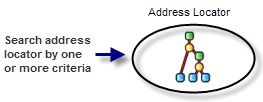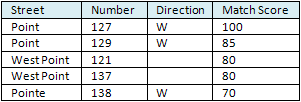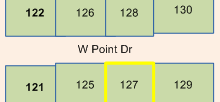Once you have created an address locator, you can begin using it to geocode addresses. However, understanding how an address locator prepares the input address data, searches the address attributes, and matches addresses—as well as knowing how modifying an address locator's settings affects this process—can help you improve both the performance and accuracy of geocoding.
The process is illustrated below:
| Step | Conceptual example |
|---|---|
|
1. Original address entered | 127 West Point Drive, Olympia, WA 98501 |
127 | West | Point | Drive | Olympia | WA | 98501 127 | West Point | Drive | Olympia | WA | 98501 | |
| |
| |
| |
|
| |
127 W Point Dr, Olympia, WA 98501 | |
|
Address parsed
When an address locator parses an address, it dissects the address into its address elements based on the style of the address locator. For example, in the address 123 Main Street, 123 is the house number, Main is the street name, and Street is the street type. Sometimes, an address can be parsed in more than one way. Although West is usually interpreted as a street direction in the address 127 West Point Drive, it may also be considered as a street name, West Point, in certain cases. To increase the chance of finding the address, the address locator parses an address into one or more distinct sets of address elements required for the geocoding process.
Multiple representations of the address created
Many elements of an address, such as direction or street type, are often written using an abbreviation. These abbreviations are presented in a variety of formats. For example, Avenue could be abbreviated as AV or AVE or spelled out completely as Avenue. As defined in the address locator style, a list of values for each address component is established. In the address of 127 West Point Drive, Olympia, WA 98501, for example, each address component contains multiple values or representations as shown in this table.
Address locator searched
Once the address locator has parsed the address and generated a list of values for each address component, it finds features in the locator that match the elements of the input address based on a set of search criteria. If address candidates cannot be found using one set of criteria, such as searching the address by its city, state, and ZIP Code, the search continues using less restricted criteria, such as address and ZIP Code only, until all the likely match candidates are found.
Score of each potential match established
When the address locator has generated a set of potential location candidates, it scores each candidate to determine how closely each one matches the address that you are geocoding. Each potential candidate is assigned a score from 0 to 100. Each address element is used to generate this score. The score for each potential candidate will be lower if any of the following apply to address elements:
- Misspelled—Long or unusual street names, such as Pennsylvania and Ahwatukee, can be misspelled easily.
- Incorrect—For example, the street number of the address does not fall within the address range for the candidate.
- Missing—For example, the street direction is specified in the address data but not in the potential candidate.
List of candidates filtered
Once each candidate is scored, the address locator generates a set of candidates that are potential matches for the address based on the minimum candidate score set for the address locator. Those potential matches that have a score lower than the minimum candidate score are removed from the potential match list.
Best candidate matched
The address locator ranks and displays the candidates by score. You can review and select the match. In table matching, an address is matched automatically to the candidate with the highest score.
Indicate matched feature
As the final step in the geocoding process, the feature that corresponds to the best candidate is used for generating the location for the matched address. The location may be based on an interpolation along a line feature, including side offset and end offset parameters, or on a polygon centroid if the reference feature is an area or point.




